Ragdoll
Felis catus
Ragdoll cats are known to go limp in one's lap or arms, hence the name.
Advertisement
Ragdoll Scientific Classification
- Kingdom
- Animalia
- Phylum
- Chordata
- Class
- Mammalia
- Order
- Carnivora
- Family
- Felidae
- Genus
- Felis
- Scientific Name
- Felis catus
Read our Complete Guide to Classification of Animals.
Ragdoll Conservation Status
Ragdoll Facts
- Fun Fact
- Ragdoll cats are known to go limp in one's lap or arms, hence the name.
- Most Distinctive Feature
- Gorgeous blue eyes
- Other Name(s)
- Floppy cat
- Temperament
- Affectionate, calm and friendly
- Diet
- Omnivore
- Average Litter Size
- 4
- Common Name
- Ragdoll
- Slogan
- One of the larger breeds of domestic cat!
- Group
- Medium-hair
View all of the Ragdoll images!
Meet the Ragdoll, the cat that will go floppy when you cuddle with it.

Breed History
The Ragdoll cat breed came about from humble beginnings in 1963 courtesy of Ann Baker, a breeder from Riverside California. This woman owned a white long-haired female named Josephine who she had taken in from the neighborhood she lived in. Ann took an interesting route by cross-breeding Josephine not only with random cats that she already owned but also with other neighborhood strays. The results of these pairings were litters that had unique characteristics she was fond of. From these litters, she chose the offspring with the best temperaments and appearances for her new breeding program. One male kitten she supposedly chose who she named Raggedy Ann Daddy Warbucks looked like a male Birman cat. She used him and his brother Blackie to further develop her new breed.
See all of our expert product reviews.
In 1966, the Ragdoll cat was registered as a new breed, and in 1971, Ann Baker founded the International Ragdoll Cat Association (IRCA) to further the importance of the breed. Whatever the particular characteristics individual Ragdoll cats owned, the one thing they all have in common is that they were the result of their queen mother Josephine.
What to Know Before You Buy
- The ragdoll will not get their full coat and color until about 3 years old. All ragdolls are born pure white, but most start to develop their coloring before they are 2 weeks old.
- The ragdoll has a large head with a modified wedge on it and blue eyes.
- Ragdolls are heavy-boned large-size cats that can weigh up to 20 pounds. With their long-haired coats, they look even bigger.
- Ragdolls go limp with pleasure, especially when they are being cuddled. It is this trait that gives this animal its name.
- Ragdolls are generally healthy, but they can be suspectable to bladder stones and hypertrophic cardiomyopathy.
Ragdoll’s Blue Eyes
The gorgeous blue eyes of the ragdoll are what attract many people to this breed. The eyes should be wide-set and modestly slanted. They should look great with the wedge on this cat’s face.

©Luxurious Ragdoll/Shutterstock.com
Personality
Ragdolls are very loyal animals who love to be with you every second of the day. They will follow you around your home in hopes that you will pay them some attention. If you shut the door, then expect to see a paw trying to get under it as this animal wants in to play with you. Owning a ragdoll often means that you will have less space in bed as many love to sleep with their owners.
Expect to spend time cuddling your ragdoll. Do not be surprised when they suddenly go limp in your arms. Their ability to go limp, like a ragdoll, is where this animal gets its name.
Health and Entertainment for your Ragdoll
See all of our expert product reviews.
These animals are brilliant. You can teach them games, like fetch. They usually learn very quickly. They love to play and will often carry their favorite toy around in their mouths.
The personality of the ragdoll is often very trusting and docile. While that makes them a great family pet, you need to watch your ragdoll. They trust that they may get into trouble with predators, like large dogs who do not like them.
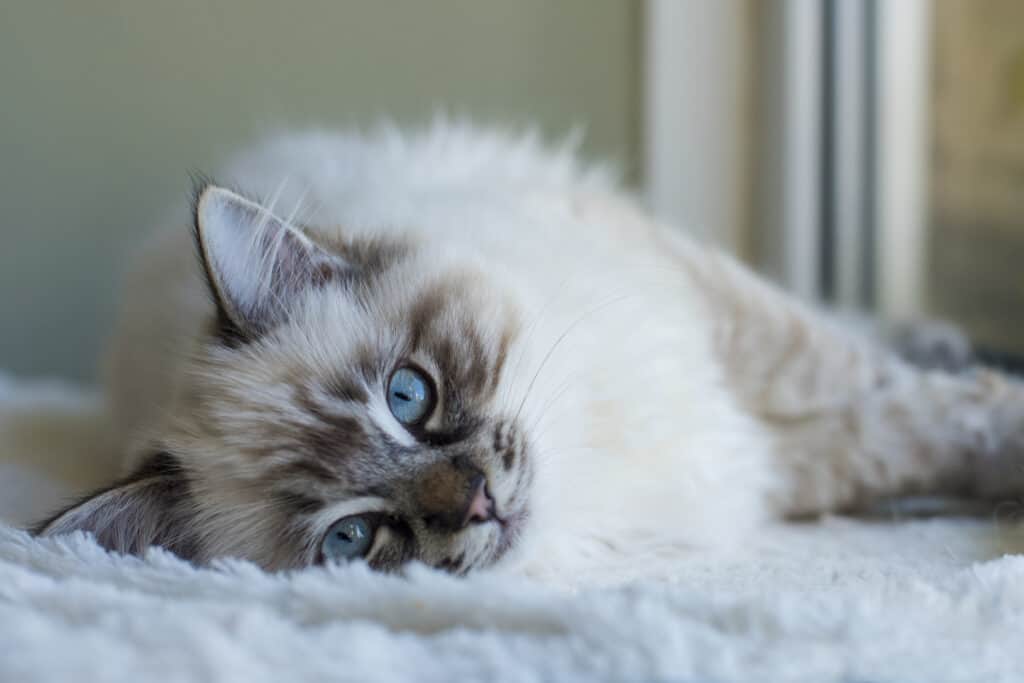
©cath5/Shutterstock.com
Size and Weight
While ragdolls are not as big as Maine Coons, they are still huge cats. They look bigger because of their long hair, but they should also be heavy-boned. The average male ragdoll weighs 20 pounds while females usually weigh between 10 and 15 pounds. That can be a lot of animals to hold when they suddenly decide to go limp.
By comparison, the domestic shorthair typically weighs between 8-and-10 pounds. Since these animals are much bigger, they often require larger toys, a bigger litter box, and more room.
Besides the Maine coon, there are other large-size cats that you may want to consider if you do not think the ragdoll is the right breed for you. Think about the Chausie as they weigh between 15 and 20 pounds or the Siberian as they can weigh between 10 and 20 pounds.
Most ragdolls stand between 9-and-11-inches tall at the shoulders. By comparison, the average Persian can stand between 8-and-10-inches tall, but it only weighs between 7-and-12 pounds on average.

©Cindy Creighton/Shutterstock.com
Price
The price of the ragdoll can vary between $150 for one gotten from a shelter to over $2,500 for a show-quality animal. There is also a lot of difference depending on the region where you are looking to buy a ragdoll. They are a little cheaper in the United Kingdom, where the average price is $700. You can find ragdolls for about $50 in Nigeria and $50 in China. In Australia, you will have to pay about $2,000 for a ragdoll.
Think about adoption. Remember that when you opt for adoption through a reputable organization, the animal often has already received basic medical care and sterilization. Therefore, the cost of adoption often is much lower than buying from a breeder.
Even across the United States, prices can vary. Expect to pay about $2,000 in New York while you may find the same quality sells for about $950 in Arizona. That same quality cat may cost you about $500 in Florida.
The quality of the animal that you are considering can make a lot of difference. For example, you will have to pay top dollar for a show-quality animal, with those who are proven breeders selling for over $2,500. A pet-quality animal from a recognized breeder may cost about $450, while those coming from a shelter may cost even less.
Keep in mind that the initial cost of getting a ragdoll is only part of the cost. You will also need to pay for wellness checks, dental cleaning, and lab work from your veterinarian. You can expect these costs to add up to about $200 per year.
You will need toys and bedding. While this breed is docile, its large size means that you may go through these items faster. Additionally, you can expect to pay about $240 annually to feed the animal.
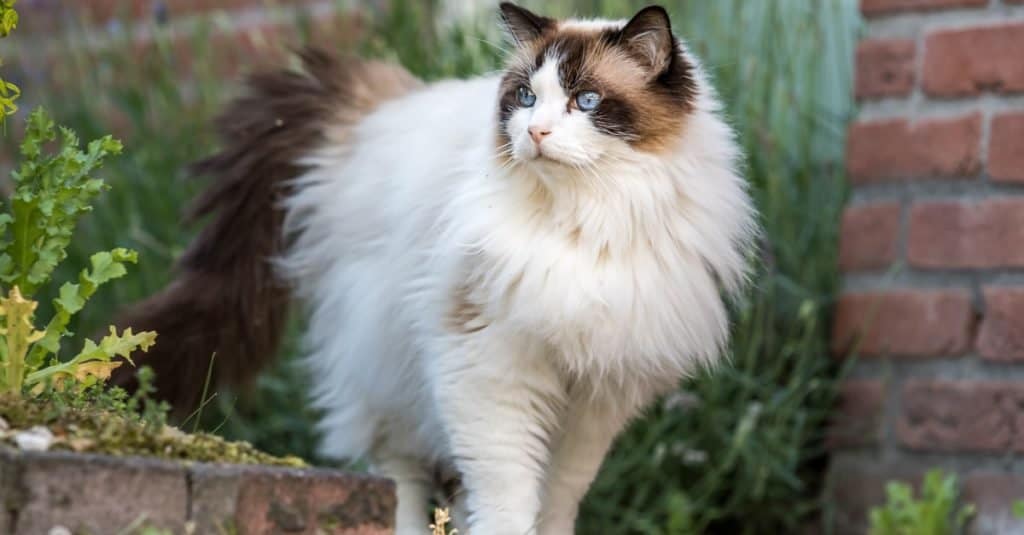
©Serita Vossen/Shutterstock.com
Kittens
By the first month, ragdoll kittens usually weigh between 0.8 and 1.7 pounds. That is almost three times the size of an average kitten as they generally weigh between 3-and-5 ounces. By the end of the second month, these animals usually double in size to weigh almost 3 pounds. Do not be surprised when a ragdoll kitten weighs over 6 pounds when it is 6 months old.
All ragdolls start white. Some kittens will begin developing their colors at about 2 weeks, while others will take longer. Generally, bicolor ragdoll will develop their colors first, with others following. A kitten may not get their full colors until they are 2 or older.
You can use the colors of the parents to predict the kitten’s colors. For example, if you breed two seal-point ragdolls, you are more likely to get seal-point kittens since seal-point is a dominant gene. Alternatively, if you want a kitten with a non-dominant gene color, such as lilac, both parents must be lilac.
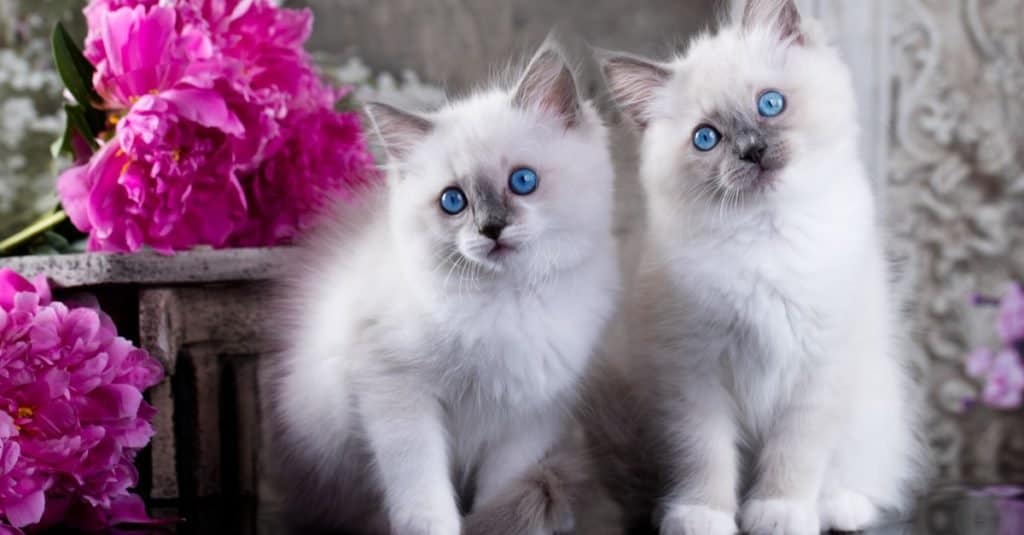
©Liliya Kulianionak/Shutterstock.com
Lifespan
The Ragdoll is one of the longest-living cats in the world. On average, they live for about 15 years. That is comparable to the average lifespan of the Balinese and the Russian Blue.
These animals are very slow maturing. They usually do not reach their full height and weight until they are about four years old.
While the average cat lives 12-to-15 years, some owners of ragdolls report that their cat is older than 23. Owner Lucas Duxbury says that the animal he calls Grandma Cat is very vocal. While she does not always make it to the litter box anymore, she still wants to be involved in what he is doing. Lucas, who lives in Canada, also says that Grandma Cat’s hair mats more than his younger ragdolls.

©Peredniankina/Shutterstock.com
Breed Vs. Mixed
There are several ways that you can determine if you are looking at a ragdoll or a mixed breed, including:
- Ragdoll cats have blue eyes. If the cat has a different colored eye, it is not a ragdoll.
- Ragdoll cats have long coats. If the coat is short, then it is not a full-blood ragdoll.
- Ragdoll cats are large cats. Even as kittens, these cats weigh a lot more than the average kitten because of their large-bone structure.
- Ragdoll cats want to be with you, and they will play games. If the cat is avoiding you, then chances are it is not a ragdoll.
- Ragdoll cats are docile. They want to be cuddled and will go limp when you are petting them.
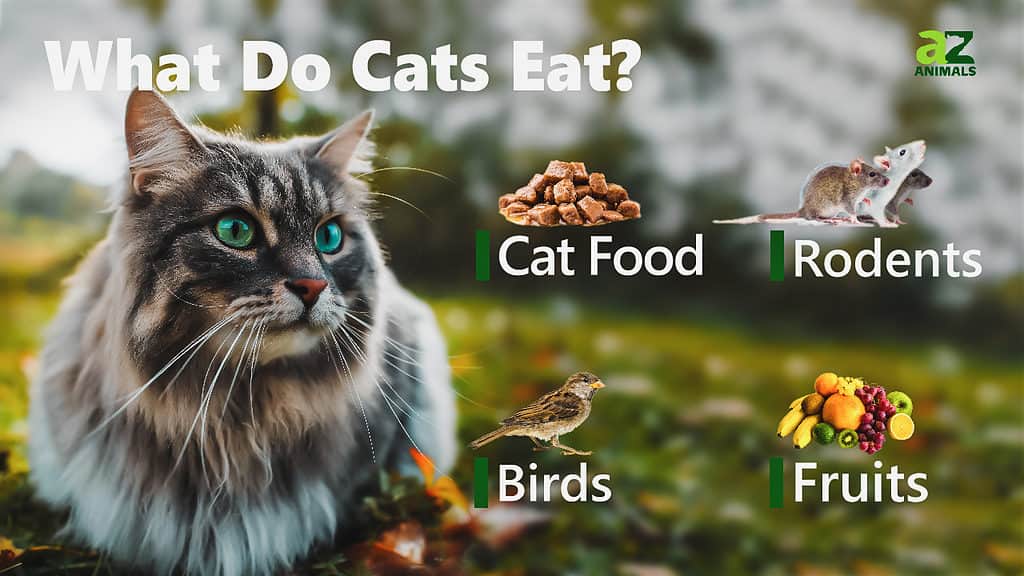
Types of Ragdoll Cats and Colors
There are many different color combinations in these cats. The ragdoll cat’s coloring can be mitted, which in some cases can appear only on the back legs. It looks as if the cat is wearing mittens over its paws. The mitted coloring can go farther up the legs of other cats, giving the cat look the appearance of wearing thigh highs.
These cats can also be pointed. These cats have no white markings on their bodies as adults. The tail, face, ears, nose, and feet of these cats are darker than their bodies.
There are also bicolored ragdoll cats. In this case, they have a white inverted V on the face with a pink nose. Then, they have different colors on their tail, face, ears, and feet. Setting these cats apart, a lighter shade of this color forms a saddle shape on the cat’s back.
These cats can also have a lynx pattern. These cats look similar to a tabby. They have an M-shape of color on their faces. Then, they have stripes on their bodies, which are often only present on the legs.
Almost all ragdolls have color point coats. The color point coat can be of any of the selected patterns. One color point coat is not seen as better than another.
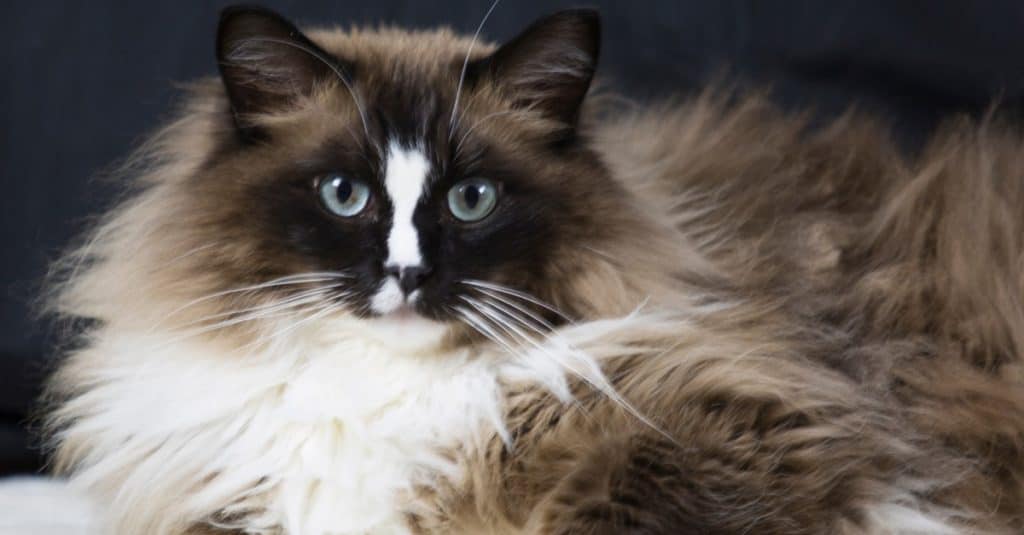
Almost all ragdolls have color point coats, which can come in varied patterns. Pictured is a Mink Seal Point Mitted, with Blaze, Ragdoll Cat.
©Sherri E. Wyatt/Shutterstock.com
In general, the Ragdoll Fancier’s Club recognizes five types of ragdoll coat patterns:
- Colorpoint
- Bicolor
- Mitted
- Lynx Point
- Tortie Point
Ragdoll cats come in six different colors, including:
- Chocolate – The chocolate color can range from a light brown, like a hot chocolate color, to a very dark brown, like your favorite candy bar.
- Seal –These cats have very dark brown on their bodies. Many look like extremely large Siamese cats.
- Lilac – This color ranges from light to medium gray with a pink hue.
- Blue – This color ranges from light to medium gray, but it has a blue hue.
- Flame – Sometimes called red, these cats have an orange cast, which can be very faint or much more prominent.
- Cream – These cats have an off-white body that can range from an orangish to chocolate tint.
Given the variations in colorings and coat patterns, here’s a more exhaustive list of types of Ragdoll cats:
- Seal – Includes seal colorpoint, seal mitted, and seal bicolor varieties.
- Blue – Includes blue colorpoint, blue mitted, and blue bicolor varieties.
- Chocolate – Includes chocolate colorpoint, chocolate mitted, and chocolate bicolor varieties.
- Lilac (Frost) – Includes lilac colorpoint, lilac mitted, and lilac bicolor varieties.
- Red (Flame) – Includes red colorpoint, red mitted, and red bicolor varieties.
- Cream – Includes cream colorpoint, cream mitted, and cream bicolor varieties.
- Seal Lynx (Tabby) – Includes seal lynx colorpoint, seal lynx mitted, and seal lynx bicolor varieties.
- Chocolate Lynx (Tabby) – Includes chocolate lynx colorpoint, chocolate lynx mitted, and chocolate lynx bicolor varieties.
- Lilac Lynx (Tabby) – Includes lilac lynx colorpoint, lilac lynx mitted, and lilac lynx bicolor varieties.
- Red Lynx (Tabby) – Includes red lynx colorpoint, red lynx mitted, and red lynx bicolor varieties.
- Cream Lynx (Tabby) – Includes cream lynx colorpoint, cream lynx mitted, and cream lynx bicolor varieties.
- Seal Tortie – Includes seal tortie colorpoint, seal tortie mitted, and seal tortie bicolor varieties.
- Blue Cream – Includes blue cream colorpoint, blue cream mitted, and blue cream bicolor varieties.
- Chocolate Tortie – Includes chocolate tortie colorpoint, chocolate tortie mitted, and chocolate tortie bicolor varieties.
- Lilac Cream – Includes lilac cream colorpoint, lilac cream mitted, and lilac cream bicolor varieties.
- Seal Tortie Lynx (Seal Torbie) – Includes seal tortie lynx colorpoint, seal tortie lynx mitted, and seal tortie lynx bicolor varieties.
- Blue Cream Lynx (Blue Torbie) – Includes blue cream lynx colorpoint, blue cream lynx mitted, and blue cream lynx bicolor varieties.
- Chocolate Tortie Lynx (Chocolate Torbie) – Includes chocolate tortie lynx colorpoint, chocolate tortie lynx mitted, and chocolate tortie lynx bicolor varieties.
- Lilac Cream Lynx (Lilac Torbie) – Includes lilac cream lynx colorpoint, lilac cream lynx mitted, and lilac cream lynx bicolor varieties.
Ragdoll FAQs (Frequently Asked Questions)
Are Ragdolls herbivores, carnivores, or omnivores?
Ragdolls are Omnivores, meaning they eat both plants and other animals.
What Kingdom do Ragdolls belong to?
Ragdolls belong to the Kingdom Animalia.
What phylum to Ragdolls belong to?
Ragdolls belong to the phylum Chordata.
What class do Ragdolls belong to?
Ragdolls belong to the class Mammalia.
What family do Ragdolls belong to?
Ragdolls belong to the family Felidae.
What order do Ragdolls belong to?
Ragdolls belong to the order Carnivora.
What type of covering do Ragdolls have?
Ragdolls are covered in hair.
What genus do Ragdolls belong to?
Ragdolls belong to the genus Felis.
How many babies do Ragdolls have?
The average number of babies a Ragdoll has is 4.
What is an interesting fact about Ragdolls?
Ragdolls are one of the larger breeds of domestic cat!
What is the scientific name for the Ragdoll?
The scientific name for the Ragdoll is Felis catus.
Are Ragdoll Cats High Maintenance?
No, ragdoll cats are not high maintenance. Consider grooming them by cleaning their ears and clipping their nails about every two weeks.
How Much Does a Ragdoll Cat Cost?
The cost of a ragdoll cat varies widely. These cats are more expensive in the United States than elsewhere. The price also varies if you want to show or pet quality.
Why Do Ragdoll Cats Go Limp?
Most ragdoll cats go limp by instinct because they love to be cuddled by their owners. Some breeders believe that the intuition is the same one that they use as a kitten when their mothers pick them up in their mouths.
Do Ragdoll Cats Like to Cuddle?
Most ragdoll cats love to cuddle. Remember that each cat is an individual with a personality.
What is the difference between a Ragdoll and a Siamese cat?
The main difference between the two is that Ragdolls are more independent than Siamese, who require a lot of cuddling and attention. Siamese is prone to being gloomy and depressed if not given enough love. On the other hand, Ragdolls strike the perfect balance between cuddling and asserting independence.
What is the difference between Ragdolls and Ragamuffins?
The main differences between a Ragamuffin and a Ragdoll include their coats, eyes, personality, grooming, and attitude when training.
What is the difference between a Ragdoll cat and a Birman cat?
The main differences between a Birman and a Ragdoll include their size, chins, coats, personalities, and grooming requirements.
What's the difference between a Ragdoll and a Maine Coon?
The main differences between a Ragdoll and a Maine Coon cat include their size, facial features, coats, personalities, and environmental requirements.
What is the difference between a lilac Ragdoll and a blue Ragdoll?
The main differences between a Lilac Ragdoll and a Blue Ragdoll include their color, the colorpoint’s hue, rarity, and cost.
Thank you for reading! Have some feedback for us? Contact the AZ Animals editorial team.
Sources
- Cat Fancier's Association, Available here: https://cfa.org/breeds/color-prefix-chart/#ragdoll
- Vet Street, Available here: http://www.vetstreet.com/cats/ragdoll#health
- Ragdoll Love, Available here: https://ragdolllove.com/ragdoll-cat-facts/
- Floppy Cats, Available here: https://www.floppycats.com/ragdoll-cat-size-comparison-to-other-cat-breeds.html
- The Spruce Pets, Available here: https://www.thesprucepets.com/largest-domesticated-cats-4843236
- The Happy Cat Site, Available here: https://www.thehappycatsite.com/ragdoll-cat-colors/
- My Ragdoll Cats, Available here: https://myragdollcats.com/how-long-do-ragdoll-cats-live/
- Floppy Cats, Available here: https://www.floppycats.com/ragdoll-cat-colors-patterns.html
- I Am Casper, Available here: https://www.iamcasper.com/ragdoll-breed-information/
- Paws For Advice, Available here: https://pawsforadvice.com/why-do-ragdolls-go-limp/?utm_source=rss&utm_medium=rss&utm_campaign=why-do-ragdolls-go-limp

















